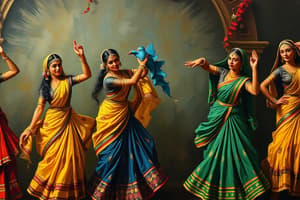Podcast
Questions and Answers
What is the primary characteristic of Bhangra, a folk dance from Punjab?
What is the primary characteristic of Bhangra, a folk dance from Punjab?
- Rapid hand movements and footwork
- Intricate hand gestures and facial expressions
- Sensuous movements and facial expressions
- Energetic movements and foot-stomping (correct)
During which festival is Garba, a folk dance from Gujarat, typically performed?
During which festival is Garba, a folk dance from Gujarat, typically performed?
- Bihu festival
- Navratri festival (correct)
- Diwali festival
- Ugadi festival
What is a common feature of folk dances across different regions in India?
What is a common feature of folk dances across different regions in India?
- Regional identity and unique styles (correct)
- Solo performances
- Similar costumes and music
- Storytelling through gestures and expressions
Which of the following folk dances is known for its seductive movements and facial expressions?
Which of the following folk dances is known for its seductive movements and facial expressions?
What is the primary purpose of folk dances in India?
What is the primary purpose of folk dances in India?
Which folk dance from Kerala is a classical dance form that tells stories through intricate hand gestures and facial expressions?
Which folk dance from Kerala is a classical dance form that tells stories through intricate hand gestures and facial expressions?
What is a characteristic of Rajasthani Folk Dances?
What is a characteristic of Rajasthani Folk Dances?
During which festival is Kolattam, a traditional dance form from Andhra Pradesh and Telangana, typically performed?
During which festival is Kolattam, a traditional dance form from Andhra Pradesh and Telangana, typically performed?
Flashcards are hidden until you start studying
Study Notes
Overview of Folk Dances of India
India is a culturally diverse country with numerous folk dances, each with its own unique style, costume, and significance. These dances are an integral part of Indian culture and are often performed during festivals, celebrations, and social gatherings.
Types of Folk Dances
- Bhangra (Punjab): a lively dance form characterized by energetic movements and foot-stomping.
- Garba (Gujarat): a circular dance performed during the Navratri festival, typically by women.
- Rajasthani Folk Dances (Rajasthan): varied dance forms like Ghoomar, Kalbelia, and Terahtaali, known for their vibrant costumes and intricate footwork.
- Bihu (Assam): a festive dance performed during the Bihu festival, characterized by rapid hand movements and footwork.
- Kathakali (Kerala): a classical dance form that tells stories through intricate hand gestures and facial expressions.
- Dandiya Raas (Gujarat): a traditional dance performed during the Navratri festival, characterized by the use of dandiya sticks.
- Lavani (Maharashtra): a sensuous dance form known for its seductive movements and facial expressions.
- Kolattam (Andhra Pradesh and Telangana): a traditional dance form performed during the Ugadi festival, characterized by the use of sticks and rhythmic movements.
Characteristics of Folk Dances
- Regional identity: Each folk dance is unique to a specific region or community.
- Storytelling: Many folk dances narrate stories, myths, or legends through gestures and expressions.
- Costumes: Vibrant and colorful costumes are an essential part of folk dances, often reflecting the region's cultural heritage.
- Rhythm: Folk dances are characterized by lively rhythms, often accompanied by traditional instruments.
- Community involvement: Folk dances are often performed in groups, promoting social bonding and community involvement.
Significance of Folk Dances
- Preservation of cultural heritage: Folk dances help preserve the cultural heritage of India's diverse regions.
- Social bonding: Folk dances promote social bonding and community involvement.
- Artistic expression: Folk dances provide an outlet for artistic expression and creativity.
- Entertainment: Folk dances are a source of entertainment and enjoyment during festivals and celebrations.
Overview of Folk Dances of India
- India is a culturally diverse country with numerous folk dances, each with its own unique style, costume, and significance.
Types of Folk Dances
- Bhangra: a lively dance form from Punjab, characterized by energetic movements and foot-stomping.
- Garba: a circular dance from Gujarat, performed during the Navratri festival, typically by women.
- Rajasthani Folk Dances: varied dance forms from Rajasthan, including Ghoomar, Kalbelia, and Terahtaali, known for vibrant costumes and intricate footwork.
- Bihu: a festive dance from Assam, performed during the Bihu festival, characterized by rapid hand movements and footwork.
- Kathakali: a classical dance form from Kerala, telling stories through intricate hand gestures and facial expressions.
- Dandiya Raas: a traditional dance from Gujarat, performed during the Navratri festival, characterized by the use of dandiya sticks.
- Lavani: a sensuous dance form from Maharashtra, known for seductive movements and facial expressions.
- Kolattam: a traditional dance form from Andhra Pradesh and Telangana, performed during the Ugadi festival, characterized by the use of sticks and rhythmic movements.
Characteristics of Folk Dances
- Each folk dance has a strong regional identity, unique to a specific region or community.
- Many folk dances narrate stories, myths, or legends through gestures and expressions.
- Vibrant and colorful costumes are an essential part of folk dances, often reflecting the region's cultural heritage.
- Folk dances are characterized by lively rhythms, often accompanied by traditional instruments.
- Folk dances promote social bonding and community involvement, often performed in groups.
Significance of Folk Dances
- Folk dances help preserve the cultural heritage of India's diverse regions.
- They promote social bonding and community involvement.
- Folk dances provide an outlet for artistic expression and creativity.
- They are a source of entertainment and enjoyment during festivals and celebrations.
Studying That Suits You
Use AI to generate personalized quizzes and flashcards to suit your learning preferences.




